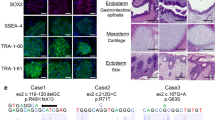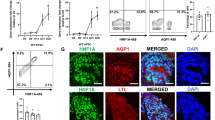Abstract
The Wilms' tumour suppressor gene, WT1, encodes a zinc-finger protein that is mutated in Wilms' tumours and other malignancies. WT1 is one of the earliest genes expressed during kidney development. WT1 proteins can activate and repress putative target genes in vitro, although the in vivo relevance of such target genes often remains unverified. To better understand the role of WT1 in tumorigenesis and kidney development, we need to identify downstream target genes. In this study, we have expression profiled human embryonic kidney 293 cells stably transfected to allow inducible WT1 expression and mouse mesonephric M15 cells transfected with a WT1 antisense construct to abolish endogenous expression of all WT1 isoforms to identify WT1-responsive genes. The complementary overlap between the two cell lines revealed a pronounced repression of genes involved in cholesterol biosynthesis by WT1. This pathway is transcriptionally regulated by the sterol responsive element-binding proteins (SREBPs). Here, we provide evidence that the C-terminal end of the WT1 protein can directly interact with SREBP, suggesting that WT1 may modify the transcriptional function of SREBPs via a direct protein–protein interaction. Therefore, the tumour suppressor activities of WT1 may be achieved by repressing the mevalonate pathway, thereby controlling cellular proliferation and promoting terminal differentiation.
This is a preview of subscription content, access via your institution
Access options
Subscribe to this journal
Receive 50 print issues and online access
$259.00 per year
only $5.18 per issue
Buy this article
- Purchase on Springer Link
- Instant access to full article PDF
Prices may be subject to local taxes which are calculated during checkout







Similar content being viewed by others
References
Bassa BV, Roh DD, Vaziri ND, Kirschenbaum MA and Kamanna VS . (1999). Biochim. Biophys. Acta, 1449, 137–149.
Bruening W and Pelletier J . (1996). J. Biol. Chem., 271, 8646–8654.
Call KM, Glaser T, Ito CY, Buckler AJ, Pelletier J, Haber DA, Rose EA, Kral A, Yeger H, Lewis WH, Jones C and Housman D . (1990). Cell, 60, 509–520.
Christiansen JH, Dennis CL, Wicking CA, Monkley SJ, Wilkinson DG and Wainwright BJ . (1995). Mech. Dev., 51, 341–350.
Davies RC, Calvio C, Bratt E, Larsson SH, Lamond AI and Hastie ND . (1998). Genes Dev., 12, 3217–3225.
Denoyelle C, Albanese P, Uzan G, Hong L, Vannier JP, Soria J and Soria C . (2003). Cell Signal, 15, 327–338.
Denys P, Malvaux P, Van Den Berghe H, Tanghe W and Proesmans W . (1967). Arch. Fr. Pediatr., 24, 729–739.
Drash A, Sherman F, Hartmann WH and Blizzard RM . (1970). J. Pediatr., 76, 585–593.
Fukada Y, Takao T, Ohguro H, Yoshizawa T, Akino T and Shimonishi Y . (1990). Nature, 346, 658–660.
Gessler M, Poustka A, Cavenee W, Neve RL, Orkin SH and Bruns GA . (1990). Nature, 343, 774–778.
Gossen M and Bujard H . (1992). Proc. Natl. Acad. Sci. USA, 89, 5547–5551.
Grimmond S, Van Hateren N, Siggers P, Arkell R, Larder R, Soares MB, de Fatima Bonaldo M, Smith L, Tymowska-Lalanne Z, Wells C and Greenfield A . (2000). Hum. Mol. Genet., 9, 1553–1560.
Gurates B, Sebastian S, Yang S, Zhou J, Tamura M, Fang Z, Suzuki T, Sasano H and Bulun SE . (2002). J. Clin. Endocrinol. Metab., 87, 4369–4377.
Haber DA, Buckler AJ, Glaser T, Call KM, Pelletier J, Sohn RL, Douglass EC and Housman DE . (1990). Cell, 61, 1257–1269.
Hammes A, Guo JK, Lutsch G, Leheste JR, Landrock D, Ziegler U, Gubler MC and Schedl A . (2001). Cell, 106, 319–329.
Hewitt SM, Hamada S, McDonnell TJ, Rauscher III FJ and Saunders GF . (1995). Cancer Res., 55, 5386–5389.
Holmes G, Boterashvili S, English M, Wainwright B, Licht J and Little M . (1997). Biochem. Biophys. Res. Commun., 233, 723–728.
Horton JD, Goldstein JL and Brown MS . (2002). J. Clin. Invest., 109, 1125–1131.
King-Underwood L, Renshaw J and Pritchard-Jones K . (1996). Blood, 87, 2171–2179.
Kreidberg JA, Sariola H, Loring JM, Maeda M, Pelletier J, Housman D and Jaenisch R . (1993). Cell, 74, 679–691.
Ladanyi M and Gerald W . (1994). Cancer Res., 54, 2837–2840.
Ladomery M, Sommerville J, Woolner S, Slight J and Hastie N . (2003). J. Cell Sci., 116, 1539–1549.
Ladomery MR, Slight J, Mc Ghee S and Hastie ND . (1999). J. Biol. Chem., 274, 36520–36526.
Larsson SH, Charlieu JP, Miyagawa K, Engelkamp D, Rassoulzadegan M, Ross A, Cuzin F, van Heyningen V and Hastie ND . (1995a). Cell, 81, 391–401.
Larsson SH, Charlieu JP, Miyagawa K, Engelkamp D, Rassoulzadegan M, Ross A, Cuzin F, van Heyningen V and Hastie ND . (1995b). Cell, 81, 391–401.
Lee SB and Haber DA . (2001). Exp. Cell. Res., 264, 74–99.
Lee SB, Huang K, Palmer R, Truong VB, Herzlinger D, Kolquist KA, Wong J, Paulding C, Yoon SK, Gerald W, Oliner JD and Haber DA . (1999). Cell, 98, 663–673.
Lee TH and Pelletier J . (2001). Physiol. Genom., 7, 187–200.
Li RS, Law GL, Seifert RA, Romaniuk PJ and Morris DR . (1999). Exp. Cell Res., 247, 257–266.
Little M, Holmes G and Walsh P . (1999). BioEssays, 21, 191–202.
Little M and Wells C . (1997). Hum. Mutat., 9, 209–225.
Llorente-Cortes V, Otero-Vinas M, Sanchez S, Rodriguez C and Badimon L . (2002). Circulation, 106, 3104–3110.
Lopez D, Shea-Eaton W, Sanchez MD and McLean MP . (2001). Endocrinology, 142, 5097–5106.
Luo XN, Reddy JC, Yeyati PL, Idris AH, Hosono S, Haber DA, Licht JD and Atweh GF . (1995). Oncogene, 11, 743–750.
Madden SL, Cook DM, Morris JF, Gashler A, Sukhatme VP and Rauscher III FJ . (1991). Science, 253, 1550–1553.
Magee T and Marshall C . (1999). Cell, 98, 9–12.
McKnight GL, Reasoner J, Gilbert T, Sundquist KO, Hokland B, McKernan PA, Champagne J, Johnson CJ, Bailey MC, Holly R, O'Hara P and Oram JF . (1992). J. Biol. Chem., 267, 12131–12141.
Moshier JA, Skunca M, Wu W, Boppana SM, Rauscher III FJ and Dosescu J . (1996). Nucleic. Acids Res., 24, 1149–1157.
Nachtigal MW, Hirokawa Y, Enyeart-VanHouten DL, Flanagan JN, Hammer GD and Ingraham HA . (1998). Cell, 93, 445–454.
Oda H and Keane WF . (1999). Kidney Int. Suppl., 71, S2–S5.
Palmer RE, Kotsianti A, Cadman B, Boyd T, Gerald W and Haber DA . (2001). Curr. Biol., 11, 1805–1809.
Park S, Schalling M, Bernard A, Maheswaran S, Shipley GC, Roberts D, Fletcher J, Shipman R, Rheinwald J, Demetri G, Griffin J, Minden M, Housman DE and Haber DA . (1993). Nat. Genet., 4, 415–420.
Pelletier J, Bruening W, Kashtan CE, Mauer SM, Manivel JC, Striegel JE, Houghton DC, Junien C, Habib R, Fouser L, Fine R, Silverman B, Haber DA and Housman D . (1991a). Cell, 67, 437–447.
Pelletier J, Bruening W, Li FP, Haber DA, Glaser T and Housman DE . (1991b). Nature, 353, 431–434.
Pritchard-Jones K, Fleming S, Davidson D, Bickmore W, Porteous D, Gosden C, Bard J, Buckler A, Pelletier J, Housman D, van Heyningen V and Hastie N . (1990). Nature, 346, 194–197.
Pritchard-Jones K, Renshaw J and King-Underwood L . (1994). Hum. Mol. Genet., 3, 1633–1637.
Quandt K, Frech K, Karas H, Wingender E and Werner T . (1995). Nucleic. Acids Res., 23, 4878–4884.
Reddy JC, Hosono S and Licht JD . (1995a). J. Biol. Chem., 270, 29976–29982.
Reddy JC, Morris JC, Wang J, English MA, Haber DA, Shi Y and Licht JD . (1995b). J. Biol. Chem., 270, 10878–10884.
Sakakura Y, Shimano H, Sone H, Takahashi A, Inoue N, Toyoshima H, Suzuki S, Yamada N and Inoue K . (2001). Biochem. Biophys. Res. Commun., 286, 176–183.
Scharnhorst V, Dekker P, van der Eb AJ and Jochemsen AG . (1999). J. Biol. Chem., 274, 23456–23462.
Sim EU, Smith A, Szilagi E, Rae F, Ioannou P, Lindsay MH and Little MH . (2002). Oncogene, 21, 2948–2960.
Simms LA, Algar EM and Smith PJ . (1995). Eur. J. Cancer, 31A, 2270–2276.
Stanhope-Baker P and Williams BR . (2000). J. Biol. Chem., 275, 38139–38150.
Tanaka TS, Jaradat SA, Lim MK, Kargul GJ, Wang X, Grahovac MJ, Pantano S, Sano Y, Piao Y, Nagaraja R, Doi H, Wood III WH, Becker KG and Ko MS . (2000). Proc. Natl. Acad. Sci. USA, 97, 9127–9132.
Thate C, Englert C and Gessler M . (1998). Oncogene, 17, 1287–1294.
Valerius MT, Patterson LT, Feng Y and Potter SS . (2002). Proc. Natl. Acad. Sci. USA, 99, 8090–8095.
Acknowledgements
We thank Selena Boyd for technical support and Dr Veronica van Heyningen, MRC Human Genetics Unit, Edinburgh, for supplying the M15 cells. This project was supported by funding from the Sylvia and Charles Viertel Charitable Trust, Australian Research Council and the National Health and Medical Research Council of Australia (ID no. 142978).
Author information
Authors and Affiliations
Corresponding author
Additional information
Data deposition: http://kidney.scgap.org/base, http://kidney.scgap.org/suppdata
Supplemetary information accompanies the paper on Oncogene website (http://www.nature.com/onc).
Rights and permissions
About this article
Cite this article
Rae, F., Martinez, G., Gillinder, K. et al. Anlaysis of complementary expression profiles following WT1 induction versus repression reveals the cholesterol/fatty acid synthetic pathways as a possible major target of WT1. Oncogene 23, 3067–3079 (2004). https://doi.org/10.1038/sj.onc.1207360
Received:
Revised:
Accepted:
Published:
Issue Date:
DOI: https://doi.org/10.1038/sj.onc.1207360
Keywords
This article is cited by
-
Breast cancer proteomics reveals correlation between estrogen receptor status and differential phosphorylation of PGRMC1
Breast Cancer Research (2008)
-
Wilms' tumor protein 1: an early target of progestin regulation in T-47D breast cancer cells that modulates proliferation and differentiation
Oncogene (2008)
-
Effects on kidney disease, fertility and development in mice inheriting a protein-truncating Denys-Drash syndrome allele (Wt1 tmT396)
Transgenic Research (2008)
-
Wilms' tumour: connecting tumorigenesis and organ development in the kidney
Nature Reviews Cancer (2005)
-
Rapid analysis of the DNA-binding specificities of transcription factors with DNA microarrays
Nature Genetics (2004)



